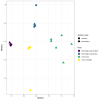Microbial diversity in four Mediterranean irciniid sponges
- PMID: 38283142
- PMCID: PMC10819633
- DOI: 10.3897/BDJ.12.e114809
Microbial diversity in four Mediterranean irciniid sponges
Abstract
This paper describes a dataset of microbial communities from four different sponge species: Irciniaoros (Schmidt, 1864), Irciniavariabilis (Schmidt, 1862), Sarcotragusspinosulus Schmidt, 1862 and Sarcotragusfasciculatus (Pallas, 1766). The examined sponges all belong to Demospongiae (Class); Keratosa (Subclass); Dictyoceratida (Order); Irciniidae (Family). Samples were collected by scuba diving at depths between 6-14 m from two sampling sites of rocky formations at the northern coast of Crete (Cretan Sea, eastern Mediterranean) and were subjected to metabarcoding for the V5-V6 region of the 16S rRNA gene.
Keywords: 454 GS FLX Titanium; amplicon sequencing; eastern Mediterranean; marine metagenome; pyrosequencing; sponge metagenome.
Katerina Skaraki, Christina Pavloudi, Thanos Dailianis, Jacques Lagnel, Adriani Pantazidou, Antonios Magoulas, Georgios Kotoulas.
Conflict of interest statement
No conflict of interest to declare Disclaimer: This article is (co-)authored by any of the Editors-in-Chief, Managing Editors or their deputies in this journal.
Figures
References
-
- Burgin Josephine, Ahamed Alisha, Cummins Carla, Devraj Rajkumar, Gueye Khadim, Gupta Dipayan, Gupta Vikas, Haseeb Muhammad, Ihsan Maira, Ivanov Eugene, Jayathilaka Suran, Balavenkataraman Kadhirvelu Vishnukumar, Kumar Manish, Lathi Ankur, Leinonen Rasko, Mansurova Milena, McKinnon Jasmine, O’Cathail Colman, Paupério Joana, Pesant Stéphane, Rahman Nadim, Rinck Gabriele, Selvakumar Sandeep, Suman Swati, Vijayaraja Senthilnathan, Waheed Zahra, Woollard Peter, Yuan David, Zyoud Ahmad, Burdett Tony, Cochrane Guy. The European Nucleotide Archive in 2022. Nucleic Acids Research. 2022;51 doi: 10.1093/nar/gkac1051. - DOI - PMC - PubMed
-
- Claesson Marcus J., O'Sullivan Orla, Wang Qiong, Nikkilä Janne, Marchesi Julian R., Smidt Hauke, de Vos Willem M., Ross R. Paul, O'Toole Paul W. Comparative Analysis of Pyrosequencing and a Phylogenetic Microarray for Exploring Microbial Community Structures in the Human Distal Intestine. PLOS One. 2009;4(8) doi: 10.1371/journal.pone.0006669. - DOI - PMC - PubMed
-
- Finstad Anders Gravbrøt, Andersson Anders, Bissett Andrew, Fossøy Frode, Grosjean Marie, Hope Michael, Kõljalg Urmas, Lundin Daniel, Nilsson Henrik, Prager Maria, Jeppesen Thomas Stjernegaard, Svenningsen Cecilie, Schigel Dmitry, Abarenkov Kessy, Provoost Pieter, Suominen Saara, Frøslev Tobias Guldberg. Publishing DNA-derived data through biodiversity data platforms. GBIF Secretariat. 2023 doi: 10.35035/doc-vf1a-nr22. - DOI
LinkOut - more resources
Full Text Sources


